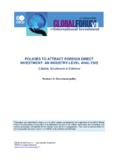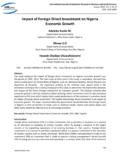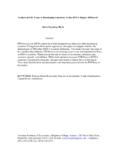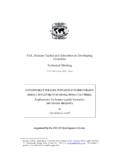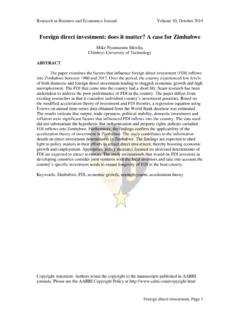Transcription of NOTE NUMBER 327 viewpoint - World Bank
1 ViewpointPUBLIC POLICY FOR THE PRIVATE SECTORTHE World BANK GROUP FINANCIAL AND PRIVATE SECTOR DEVELOPMENT VICE PRESIDENCYB usiness opportunities as reflected in the size and growth potential of markets are the most powerful drivers of foreign direct investment . But investment climate features such as strong institutions and investor-friendly regulations also matter and may even boost the development impact of the investment . Moreover, many elements of the investment climate can be reformed in the short run and at comparatively low cost. Improving the investment climate therefore offers an excellent opportunity for countries seeking to attract foreign direct are promising trends in global foreign direct investment (FDI) flows for developing and transition economies.
2 Each year more and more FDI is flowing not only from developed into developing economies but also from one developing or transition economy to another. Indeed, developing and transition economies share of global FDI inflows rose from roughly 19 percent in 2000 to 52 percent in 2010 for the first time exceeding half the total (figure 1). And half the top 20 FDI recipients in 2010 were developing or transition is good news, because FDI accounts for a whopping 11 percent of global GDP and more than 80 million jobs worldwide (UNCTAD 2010). Today there is greater potential than ever for devel-oping and transition economies to take advantage of job creation and investment opportunities by attracting FDI. Global FDI inflows totaled US$ trillion in 2010 (UNCTAD 2011b).
3 They are pro-jected to reach US$ trillion in 2011 and head toward US$ trillion in 2012 (UNCTAD 2011b). And senior executives of multinational corporations are becoming more optimistic about investment prospects for 2011 12, particularly about opportunities to invest in key developing and transition economies (UNCTAD 2011a). How Much Does investment Climate Matter?Kusi Hornberger, Joseph Battat, and Peter KusekKusi Hornberger is an economist, and Peter Kusek a senior investment policy officer, with the World Bank Group s investment Climate Department. Joseph Battat is a retired former manager of the department with more than 30 years of ex-perience advising govern-ments and multinational companies on investment location 2011 NOTE NUMBER 327 Attracting FDIF igure More FDI is flowing into developing and transition economies than ever before1 Source: UNCTAD of total FDI inflows19%52%20002010 DevelopedeconomiesDeveloping andtransitioneconomies81%48%2 ATTRACTING FDI HOw MuCH DOES investment CLIMATE MATTER?
4 ATTRACTING FDI HOw MuCH DOES investment CLIMATE MATTER?What drives decisions on where to invest?Research has identified motivations driving companies to undertake different types of FDI (USAID 2005): n Natural-resource-seeking FDI to gain access to a natural resource not available in the com-pany s home market. n Market-seeking FDI to gain access to new cus-tomers, clients, and export markets. n Efficiency-seeking FDI to reduce production costs by gaining access to new technologies or competitively priced inputs and Strategic-asset-seeking FDI to go after strategic assets in a local economy, such as brands, new technologies, or distribution channels. However, these drivers do not highlight the importance of the quality of institutions and regu-lations in the host economy that is, its investment climate.
5 This factor may be of more importance to foreign companies investing in the services sector. Studies suggest a diverse set of factorsIn the past few decades hundreds of theoretical and empirical studies have attempted to pinpoint the main factors in investors decisions on where to invest. Most empirical work has found that mul-tiple factors are significantly associated with FDI inflows and that in some cases they interact. The determinants identified as significant vary depend-ing on the countries, sectors, years, and types of investment studied. And many studies have been unable to overcome econometric identification challenges. Thus a definitive understanding of what drives investment decisions would require an understanding of the context for each FDI project.
6 These limitations do not mean that we cannot draw some basic conclusions from the empiri-cal studies of FDI determinants. Looking at a set of 30 empirical studies that focus on developing and transition economies, and that have been conducted since 2000, reveals some interesting The studies vary in geographic cover-age, with some focusing on transition economies in Eastern Europe and Asia, some on Africa or Latin America only, and some on single countries. Regardless of geographic focus, a majority of the studies find that the size and growth potential of markets are significantly associated with FDI inflows (figure 2). More interestingly, institutional and regula-tory quality (that is, the investment climate) and trade openness seem to matter. Many of the stud-ies identify measures of these features as being significantly associated with FDI inflows.
7 And surprisingly, none of the studies identifies avail-ability of natural resources as significant. This may be because few of the studies focus explicitly on FDI in natural resources, however, or because there are few or no cross-country indicators that measure the availability of natural resources as a whole. New data sources confirm findingsAnalysis based on new data sources confirms the findings of the review of empirical studies. Market size mattersThere is no question that market size matters for attracting FDI. The World s largest economies attract the most FDI. Together, the World s 10 largest economies accounted for 47 percent of Figure Empirical studies show that market size and potential are significantly associated with FDI inflows2 Note: Many of the 30 studies identify multiple factors as significant.
8 For a list of the studies, go to a. Includes a wide range of indicators, such as Kaufmann governance indicators, Doing Business indicators, Investing Across Borders indicators, International Country Risk Guide (ICRG) indexes, World Business Environment Survey data, and the Freedom House Index of Economic Freedom. Source: Authors citing factor as significant determinant of FDI0051015202530 Natural resource availabilityCultural linksLabor quality and costsEconomic and political stability Infrastructure qualityTrade opennessInstitutional and regulatory qualityaMarket size and potential33all FDI inflows in 2010. The United States, the World s largest economy, remained the top FDI destination, receiving US$228 billion. Following is China, the most populous, which received more than US$106 billion (UNCTAD 2011b).
9 Market potential may matter moreFor developing and transition economies, per-haps more important than market size is market growth potential. The economic growth expecta-tions based on population and income growth prospects mean that many emerging economies offer foreign investors high potential returns on investment and there has been an FDI boom in the World s leading emerging markets. FDI flows into Brazil, the Russian Federation, India, China, and South Africa the BRICS economies have grown by an average 28 percent a year over the past five years. These five economies accounted for 18 percent of the World s FDI inflows in 2010, with a combined US$222 billion. The market potential angle gives developing regions hope for future prosperity. This is espe-cially so for Sub-Saharan Africa, given its high and relatively stable GDP growth in recent years.
10 Research by the McKinsey Global Institute (2010) suggests that Africa has more high-return invest-ment opportunities than any other developing region. A survey by Ernst & Young (2011) forecasts FDI inflows for Africa of US$150 billion in 2015. But investment climate matters tooWith market size and potential held constant, what other factors seem to be important to for-eign companies seeking to invest in developing and transition economies? Evidence suggests that the investment climate matters quite a bit. For nearly 30,000 FDI projects in the fDi Markets database for which a location determinant is identified, the investment climate (proxied by the dual factors of business regulations and gov-ernment support) was the third most important investment motivation (cited in 12 percent of cases; figure 3).










